Working with my hands is something I enjoy whether making something creative, doing handyman stuff and DIY, holding donuts and coffee, gardening or performing a random task of some sort; I get satisfaction out of standing back at the end and saying, I did that.
As a shooter who makes his own ammunition, my hands are often busy doing that and over the last couple weeks I've been making a lot of ammunition for all of the calibres of firearms I own.
Yesterday, I was focused on .243 rounds. I've been doing the preparation work on the cases over time, some of which I've written about before here, and recently worked on the last stage, adding the gun powder and projectile to finish off the ammunition completely.
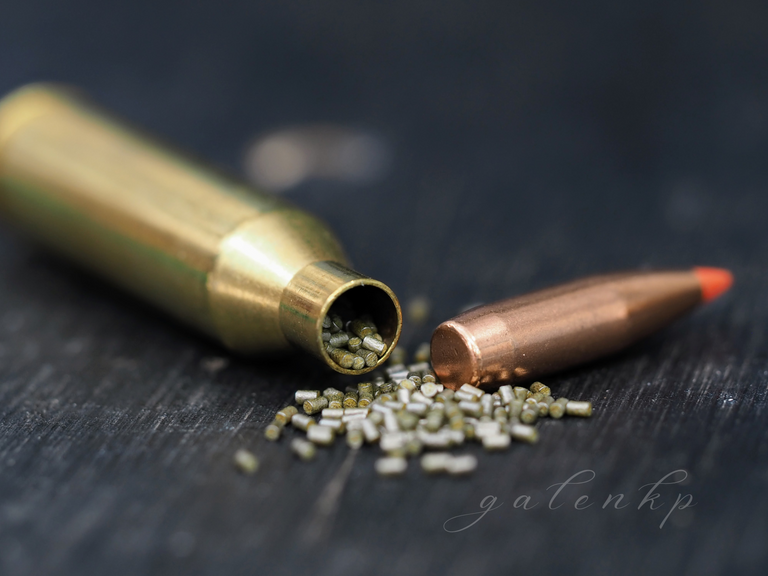
This is a fairly slow process for me as I don't use any automated or electronic equipment. I figure it's best to know how to do it without and I find I'm more precise when doing it myself, with my hands and brain.
When shooting at long range I'm looking for precision, accuracy and repeatability which starts with the ammunition. Making it myself, to my exacting standards, means I can be very precise and a low standard deviation (SD) in muzzle velocity means better precision, accuracy and repeatability down range. Mass-produced factory ammunition can never be that precise as they need to push out millions of rounds very quickly. About ten billion rounds are made in a single year in America alone so they're not as precise as handloads.
Anyway, because this stage isn't messy and happens quite sedately I took a few photos as I went.
Below is the powder I use for this particular ammunition. It is ADI AR2209 made here in Australia. I've developed a load specifically for the rifle this is used in which consists of 40.9 grains of powder. That doesn't mean 40.9 individual little pellets, a grain is a measurement of weight. For perspective, 437.5 grain-weight is equal to an ounce so you can see, it's a very small measurement.
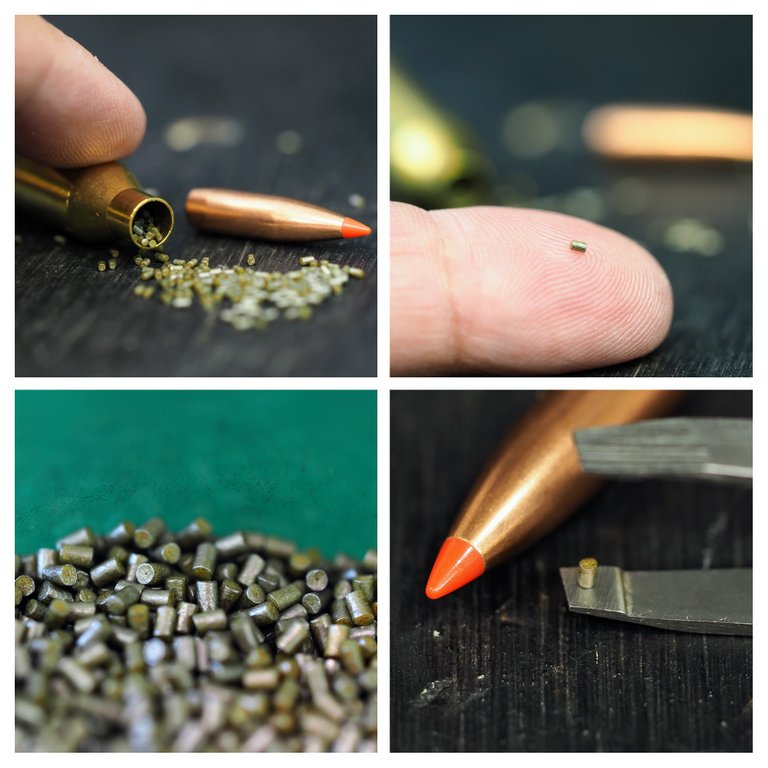
Above you can see a single AR2209 gun powder pellet on the tip of my finger and another sitting on the tip of a set of standard tweezers. I use the tweezers to add or take a pellet here or there to make sure the 40.9 grains is measured precisely. This is why it takes so long.
Also above, you can see many grains in the hopper (dispenser) that I use to throw the 40.9 grain-weight - I set this to the precise weight before the process begins but (of course) it's never perfectly accurate hence the tweezers. Below is a partial image of the hopper. It has a little handle I work up and down to release the set-measurement of powder.
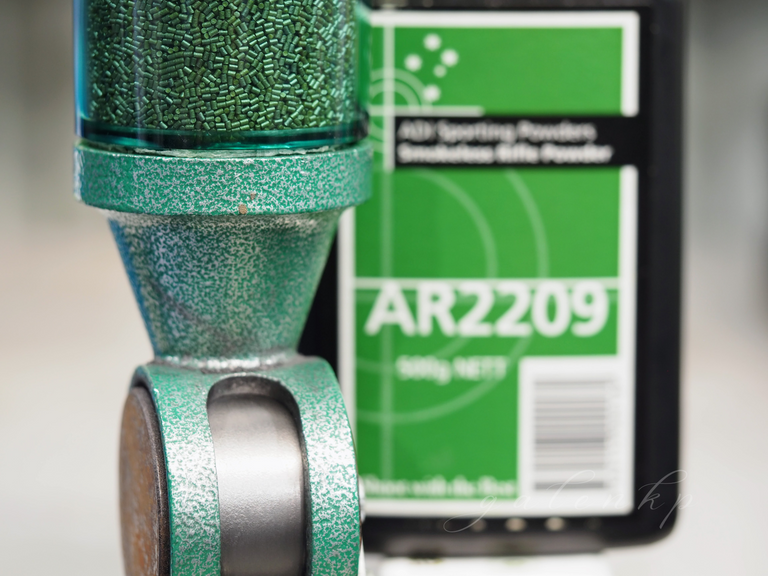
Below is an image of my beam scales. I simply set them at zero with the gold dish set upon the cradle by winding the other end of it up and down to level it off.
Once that's done I set the 40.9 grain-weight using little weights as you can see. Then I throw the measure of powder from the hopper into the gold dish (not literally throw it, that's just the term used) and then set the dish on the cradle. It's either perfect, (about 10% of the time) or I have to add or take pellets to make the weight perfectly precise. Thanks tweezers.

The powder is put into the brass case which has already undergone all the preparation work including having a new primer inserted and then is placed into the press and held there with the case holder. I take a projectile, place it into the neck and then work the handle of the press which pushes the case and projectile up into the seating die pressing the projectile into the case neck. When that is done, I have a finished round of ammunition.
There's no real trick to this process although because I work with very small tolerances and want precision, I ensure the overall length of each round is within a set tolerance that I determine during the load development process as mentioned earlier. The seating die in the press is set (by me) to push the projectile to a certain depth which then dictates the overall length (OAL) of the round.
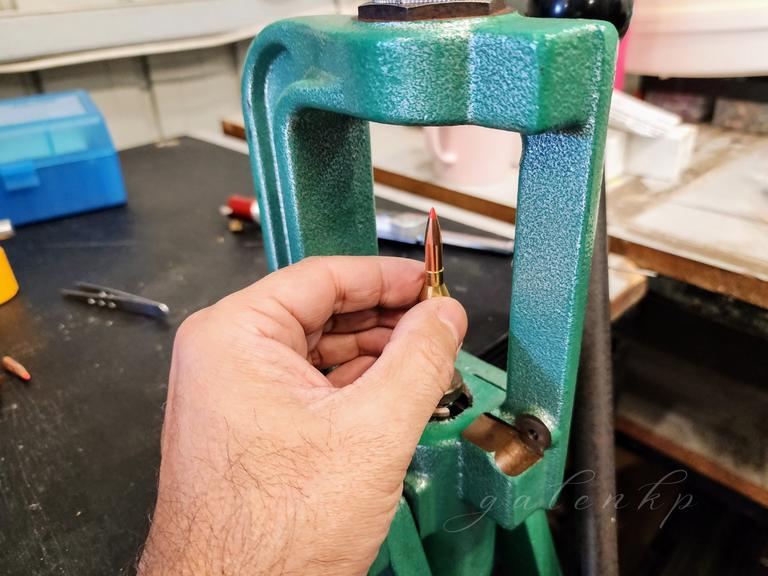
Below you can see a completed round at lower left. You might be able to make out some shavings at the neck of the round (the top of the brass part) which is fine filings that have been sheared off the projectile by the seating process. To the lower right you can see some of those shavings laying on the case holder after I've made about a hundred rounds.
The image below top is to demonstrate how far the projectile actually gets pushed into the case and these minute filings do not affect the flight of the bullet.
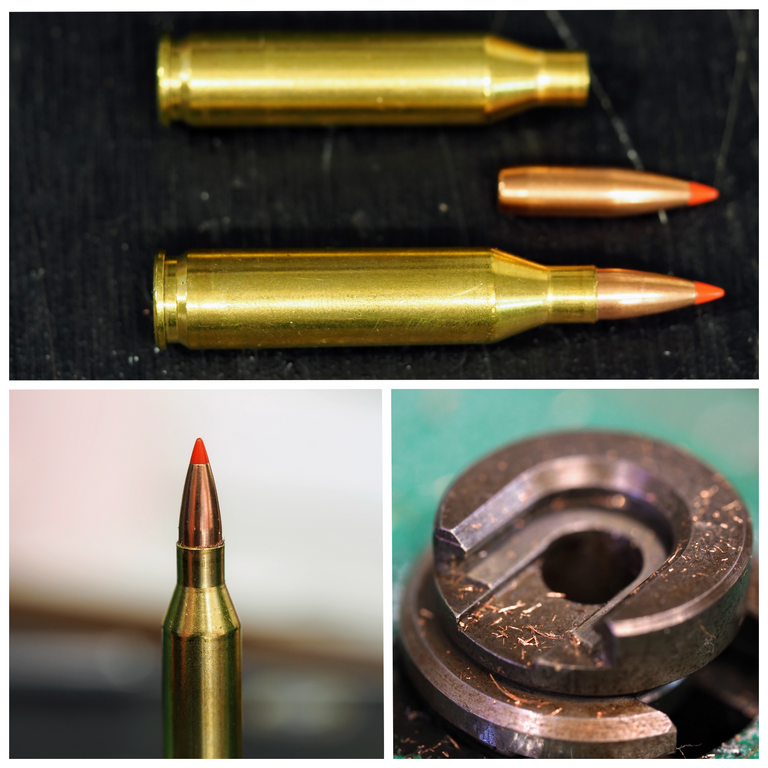
I measure each round when it is complete to ensure it is within tolerance. I generally know they will be but I like to check and recheck and over the years have found one or two that have been either too long or short. Too long and they may not feed from the magazine into the chamber properly and being too short can affect accuracy. The throat-jump (distance from the projectile's ogive to the rifle's lands) can affect accuracy. Again, I have tested all of this for each of my long range rifles and developed a load/round specifically for each; some like a linger jump and some shorter.
The OAL for these rounds is 2.17 inches measured from the base of the case to the ogive of the projectile. This is done using a comparator gauge affixed to a vernier caliper. I work around a tolerance of 2.1695 to 2.1710 inches but most hit the 2.17 exactly. Shorter or longer than that tolerance and the round is considered substandard and pulled apart to be rebuilt to meet tolerance.
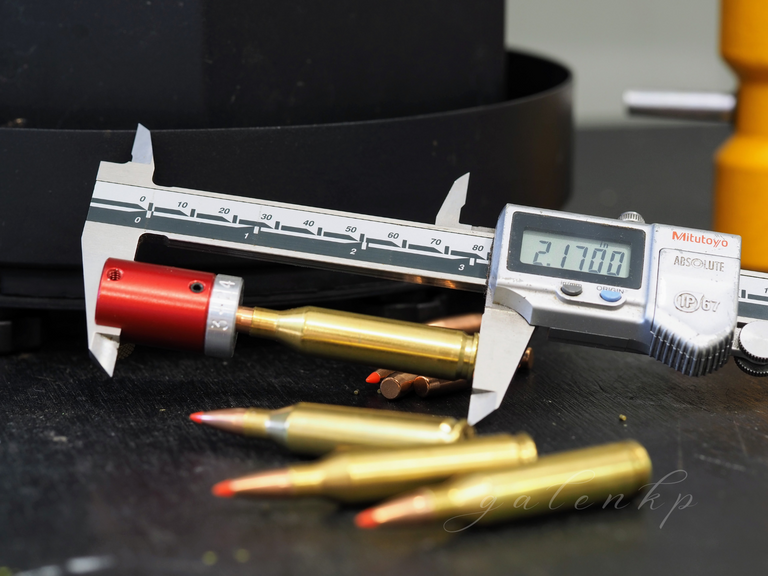
In the image below, you can see that the comparator gauge rests on the ogive and the OAL is taken from there. The reason for this is that the tip/nose of the bullet, the meplat, is not always exactly precise and the ogive is.
Once measured for length the last stage is giving the round a shake next to my ear; this is done to ensure the powder is in there, a sort of check-measure for the check I've already done and the check before that done through the reloading process. Shooting a round without powder will result in a projectile stuck in the barrel and that'll fuck up a shooters day for sure, and possibly cause injury or death.
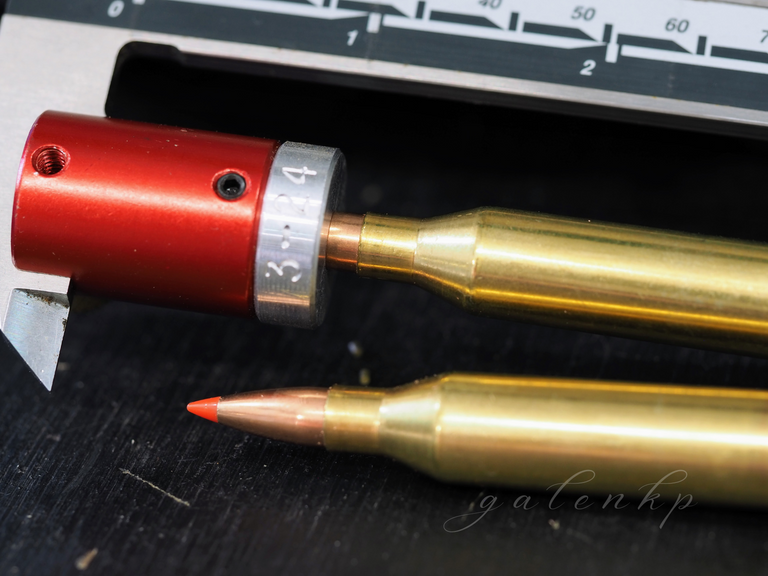
I made a couple hundred of these to bring my stock of this calibre back to its minimum of several hundred. I rotate oldest to newest as I shoot and work my way through over the course of time. It was a relaxing time, coffee, music and the repetitive process of reloading often is, (when things are going right.) It takes concentration, it's not something one wants to mess up, but having single-focus on something gives the brain a little time take a rest from all the other stuff.
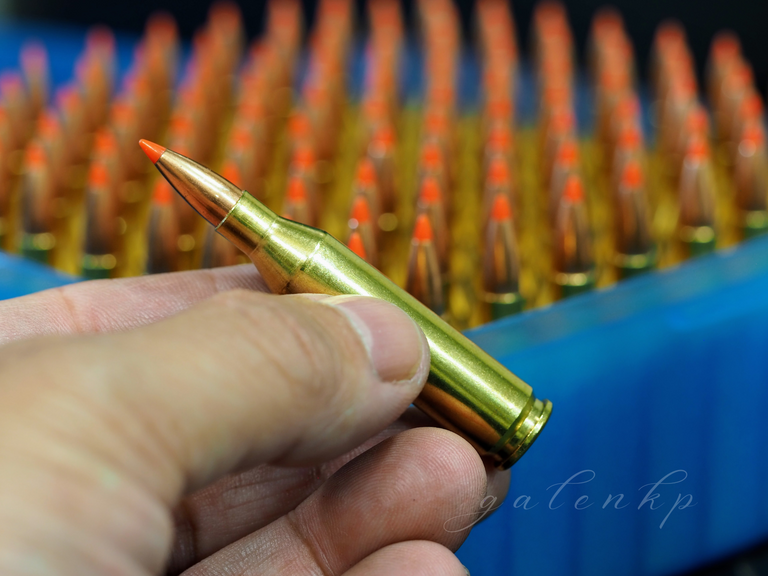
So that's it, a few very basic words about my reloading session. If you have any questions feel free to ask, I know a thing or two or feel free to make a comment if you'd like.
Design and create your ideal life, don't live it by default; tomorrow isn't promised so be humble and kind - galenkp
[All original and proudly AI free.]
Every image in this post is my own.
Olympus OM-D E-M10 Mark III was used to capture these images.
This has got to be one of the best reloading write-ups of all time. Great photos too! It could be in a top-tier hunting magazine. Great post!
Oh thanks mate, much appreciated.
You know, I'd like to do a start to finish reloading process post but it would be several thousand words long. Little snippets is not as good, but is probably better, if you know what I mean.
I really appreciate your comment man, thanks so much.
Great photos. I can't really understand exactly since I have no expertise or experience here, but I enjoyed following along as you described the process.
The way you describe it and the advantages to doing it yourself so that you control every detail, it reminds me a little of Japanese calligraphy (shodo). I'm only am amateur in that, but my wife is an expert and I watch her at it often. When you draw there, you don't just get ink as a painter would, you take an ink stone and grind the ink to be the exact way you want it. Controlling the process. Some people who try to make their own inkstones, though I understand that is more rare because it is a very intensive process to do that well.
Not exactly the same as what you are doing, but it does give me a little understanding to your goals in doing it.
Anyway, very interesting stuff!
Thanks mate, it's more about the photos I guess because it's unlikely anyone will get it as far as the reloading stuff unless they have done it or seen it done. This is why I kept it all very simplistic.
My sister in-law is full Japanese and does shodo/shūji also. It's nothing at all like making ammunition, but from the perspective of precision, control and discipline there's definite similarities. My SIL does Japanese tea ceremonies and it's the same thing, precision and discipline. I have some cool photos from a year ago of her doing one which I've been meaning to post about. I'll get around to it sometime.
I have done many small, menial tasks, and love my own DIY. One thing I have never tackled is hand-loading my own rounds.
Very cool look at the process. Some day, I may try my hand at my own .308
There's obviously a lot more to it, I've just touched in the basics of the very last stage. It's generally something that needs to be taught I think, to be able to do it well anyway. Most won't need to be as precise as I am with my long range rounds, but it's really cool chambering a round knowing what it'll do and that everyone after it will do the same thing.
.308 is a great calibre, I have a couple of them and have done some pretty decent long range shooting with them. It's a very flexible calibre.
Thanks for your comment.
For me, the 308 is something I remember learning on w/ my dad. Well, first it was a little .22, then later, after some real lessons, and some range safety, the 308. But that one has some personal meaning and history.
My first rifle was a .243 and then reasonably quickly I also bought a .308 which I really loved. I've never been much into .22's and didn't learn on one, although I recommend people do.
For us, around here, it's a natural progression. the .22 as many families have one for kids. Then, other calibers. In fact, oddly, my first was actually a .22 over a .20 ga. Shotgun. Although, dad never let us use the shotgun until we learned weapons safety, technique, etc, w/ the .22
When the hand is found doing things we are proud of, we get this self-satisfaction feeling attached to it.
As always your work on adding more ammunition to the list is lovely. I guess it helps you relax doing so because that's how I would feel when doing this mainly because I love anything regarding a gun. I find them exciting.
Yeah, hands are used to do many different things, often resulting in pleasure.
Making ammunition is quite relaxing as the mind needs to let go of everything else, concentration is needed. Once into a rhythm it's really quite enjoyable.
Haha, I knew it would be. Gosh, I can feel excitement oozing out right now. Today will be a good day.
It's good to start the day with the expectation of it going well, I hope the reality is the same and that you can look back on it and be content with what you made of it.
I hope so too. Hehe, I do hope so. Determination is the key though. I can decide to make it good for me and ignore anyone who does not tally with me.
It always fascinates me when people can do something with their own hands. It's like a kind of meditation. Unfortunately, I myself do not know how to do anything of the kind, although I have always been very eager to learn, but I never get anything interesting.
Working with one's hands is exactly that, especially when it's being done for enjoyment. We all go to work and use our hands, but when we do DIY, create art and craft, play music, make ammunition it's something different. I learned how to make ammunition a long time ago and have been doing it for years; I've never found it a chore, it's always been enjoyable and somewhat meditative as you say.
I like those pictures. I played a lot at some POV-shooting game when I was younger but never had an idea of how the bullets of the sniper were made.
Thanks for the "visual guide"
Video games are not real-life (obviously) and the concepts (usually falsely) represented in them reflect the fact they are there for entertainment purposes only. The real world is where life happens and for some shooters, (especially long range shooters like me), making one's own ammunition is an important part of the shooting process.
Video games, movies, television and such things don't represent firearms well at all, are often terribly inaccurate and misleading and generally lead people to think things that are simply not the case. Typical in the world we live in.
I like to represent shooting and firearms accurately and in a true-to-life way so people can gain some clarity and a little understanding that they won't find in those places I mention above. This post shows just one small element of the process and I've done other posts about the other stages in the past. Maybe you clicked the link I added in this one to one of my previous posts. Either way, this shows the real-world scenario in respect of handloading ammunition.
I am sure of what you say. I did not mean to sound arrogant with my "videogame experience". Just as a chemical engineer, my curiosity rose on how the ammunitions could me created and what was inside them.
I truly appreciated the explanations and the mention of the different gun-powder used for different applications
All good, I didn't think that knowing you as I do, an intelligent and worldly man. So many think that video games are true to life when the reality is they are woefully inadequate.
Donuts and coffee 🤤🤤
I'm going to the nutritionist tonight and I think he'll remove those terms from my vocabulary 😭
Reading you and looking at your photos reminded me of my Dad while he was making cartridges when I was a child, what good times and what good memories.
Oh yeah man, none for you...after today. Lol.
I like being capable man, like, being able to be self-sufficient and get things done. It brings a good level of comfort and confidence. This is just one aspect of it of course.
Being self-reliant and doing your own thing has various aspects and various levels, all of which are certainly positive.
Tonight I'll let you know what awaits me as food.
Meanwhile yesterday we had another news... boy!!!!😍
A boy! Congratulations man, nice work!
Thanks!!!🤗
If I have the option, I like to select the powder load such that a double charge will overfill the case. This avoids a double charge situation, based on advice from an old reloader. I have never done this except deliberately, but it is a simple precaution. He also used a paperclip, with a bent end to feel the bottom of the case perimeter; to reject worn cases. I have found some tired cases using this, and it isn't visible outside.
I thought you only loaded 6.5mm for the big guy. A .243 is big enough to be effective, good choice.
I have tried casting my own tips, and using gas checks on a reduced load; but I'm not too happy with it thus far. Need to commit more time to it I guess....
Liked the post, good information.
Double charge? I do a load development and determine the exact amount of powder that works the best as far as MV and accuracy.
Interesting, do you know what he's feeling for?
I've got 6.5 yes, and also larger calibres like .308 and greater. I don't say or show them all here, one never knows who's watching.
I'd like to do some casting but am not currently set up for it. A good skill I think.
Double charge is stupid, but if it overflows the problem is obvious. I do this, as he recommended; as an extra precaution.
He's feeling for the beginnings of a crack forming around the base of the case where the primer goes. It is especially apparent on high powered reloads like the 300 win mag, where the base skirt transitions to the normal case siding.
Casting can give you extra capabilities! They also have a metallized clay that can be sintered after forming!
Any dangers of explosions when pressing due to static or other variables.?
I am guessing you never leave your brass behind?
Have you ever had trouble finding one in the brush and the low light at dusk?
There's always a small chance of it, the powder is an explosive/accelerant after all, however precautions are always taken.
It's a bit like filling the car with gas, one wouldn't also strike matches, or be welding at the same time.
All brass is collected where possible, it's costly to buy. Sometimes one goes AWOL but that's rare. Like you say, low light or in bushes long grass and sometimes even in dirt and sand, they just seem to disappear. Other than that, no
manbrass gets left behind.I've never seen a bullet on the inside before, it's incredible and so much detail. Impressive accuracy and being detail oriented I love it.
Look at every picture, every detail, I love it! The truth wonderful content, as I told you once, with these things I remember my grandfather, I go back to another time. Thank you!😀
Thank you, In glad to be able to show you what's really going on. I like to represent firearms well, which is not always done considering all the wacko-shooters out there. I'm a responsible guy and like to portray the good/legit side of shooting.
Yes, I really liked the publication and especially the detail. Thank you very much!
Thank you for using the #diy tag.
As long as you keep growing your BUIDL POWER you will receive my support.
Upvoted.
Check out this post for more information about BUIDL tokens.
I appreciate your support, thank you kindly.
This is quite interesting. I guess you posted something about learning how to shoot somedays back. I never knew you can make ammunition. Even though you are not very good at it, you are still trying to get busy by putting your hands into something.
That is nice...
What the fuck does this mean? Not very good at it. Have you read this post?
I've been reloading (making) ammunition for over twenty five years so, not very good at it doesn't apply to me. My suggestion is that you read and understand posts prior to making comments on them. I remember saying this to you once before.
Please don't comment on my posts unless you have read them and understood the content. If you don't understand the content, the only comment you should be making is a one formed as a question.
Ooh no that is not what I meant. I guess you got me wrong. You mentioned about gardening or doing some random tasks and you always love to put your hands on something meaning that you love to get busy
So I was saying that even though you may not be good at those other things, you still try to do them.
Also, I didn't know that you make ammunition. I guess my explanations were not clear enough to you. I'm sorry
Ah ok, maybe your text wasn't very clear to me. I read, "not very good at it," and took that literally because that's what it said.